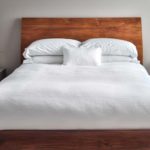Page Contents
Are you planning to purchase a new mattress? Whether you need a replacement for an old, worn-out bed, a much-needed upgrade for comfier sleep, or a spare one for a guest room, you can shop with ease and confidence knowing you have ample knowledge on how to choose a mattress that works perfectly for you. Here’s an ultimate guide to shedding light on necessary things you have to know before you swipe your card or pay in cash. Have an informed decision, and end up satisfied even after years of purchase. Be ready to answer significant questions that will lead you to the perfect mattress.
Mattress Life Span: How old is your mattress, and is it time to make a change?
How long has it been since you bought your current mattress? Did it serve you long enough to bid it goodbye, finally? The standard rule for how long a mattress lasts is eight years. If your mattress is over eight years old, perhaps it’s about time to find a replacement. With the unavoidable wear and tear your mattress has gone through the years and how it has been affecting your sleep these past few nights, its retirement has finally come.
Although most mattresses come with a 10-year or more warranty, it doesn’t vouch for the length of service a mattress could last. The warranty covers for a mattress’ craftmanship. That’s all there is. So, don’t be surprised that your mattress isn’t as comfortable how it was almost a decade ago. A perfect mattress and not worn out can offer you a comfortable and undisturbed sleep. Sleeping on it will less likely make you wake up with any sort of body pain or grogginess. The question is, “Are you still comfortable with your present mattress?” If your answer is no, you just have to let it go. It isn’t worth holding onto if it’s causing you inconvenience rather than comfort. It’s time to shell out some dime.
Innerspring (Coils)
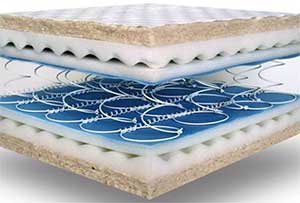 Decades ago, it’s common knowledge that the innerspring model was a staple in every bedroom. Known as a traditional type of mattress, it has a bouncy, springy feel made possible by one or multiple layers of spring coils sewn into every fabric pocket. An innerspring mattress can have continuous coils, Bonnell coils, offset coils, or pocketed coils.
Decades ago, it’s common knowledge that the innerspring model was a staple in every bedroom. Known as a traditional type of mattress, it has a bouncy, springy feel made possible by one or multiple layers of spring coils sewn into every fabric pocket. An innerspring mattress can have continuous coils, Bonnell coils, offset coils, or pocketed coils.
Pros
- It is affordable and widely available.
- It has excellent edge support compared to memory foam and latex.
- The wide gaps between the springs promote air circulation throughout the mattress, making it a perfect mattress for hot sleepers.
- It’s highly durable. The springs tend to keep their shape for many years.
Cons
- The coils produce sound on every movement, making it hard to deal with, especially if you sleep with someone who frequently moves at night.
- It doesn’t perform well in isolating motion transfer.
- It doesn’t conform to the body’s shape, making it a poor choice for pressure point relief.
- It tends to lose its support as it ages, leading to sagging and uneven surface.
Memory Foam
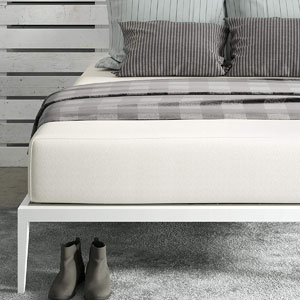 If you prefer a mattress that offers body-conforming, pressure point relief, and outstanding support, you can never go wrong with a memory foam mattress. With its increasing popularity for years, manufacturers came up with different varieties to address the needs of each sleeper. Since one of the main drawbacks of memory foam is it traps body heat, more advanced memory foams now have cooling properties like the copper-infused Layla Mattress and the patented buckling-column gel foam Original Purple Mattress, making them more cooling than traditional coiled mattress.
If you prefer a mattress that offers body-conforming, pressure point relief, and outstanding support, you can never go wrong with a memory foam mattress. With its increasing popularity for years, manufacturers came up with different varieties to address the needs of each sleeper. Since one of the main drawbacks of memory foam is it traps body heat, more advanced memory foams now have cooling properties like the copper-infused Layla Mattress and the patented buckling-column gel foam Original Purple Mattress, making them more cooling than traditional coiled mattress.
Pros
- Memory foams are widely available, whether in physical stores or online.
- With many choices nowadays, memory foams are relatively affordable.
- A memory foam mattress conforms to the body, just like hugging it comfortably. It cradles the pressure points of the body, offering superior pressure relief.
- It distributes weight evenly, promoting spine alignment.
- It isolates motion transfer and produces no squeaking sound.
Cons
- Some memory foam mattresses can give off odd chemical smell. According to the Sleep Products Safety Council, letting it air out for at least 24 hours before putting the bedsheet helps dissipates the smell.
- It retains body heat, so hot sleepers may have a restless sleep on a memory foam mattress.
- A super-soft memory foam mattress lets your body sink, offering low firm support for the body. It’s a big downer for toss-and-turners who like to switch positions while at sleep.
- Since it’s made entirely of foam, it can be prone to sagging.
- It offers poor edge support.
Latex
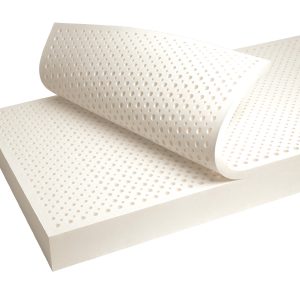 If you want a versatile sleeping surface that combines comfort and support, a latex mattress is a worthy match. It contours to the body’s shape while it supports and relieves pressure points. It comes in two types: natural and synthetic latex.
If you want a versatile sleeping surface that combines comfort and support, a latex mattress is a worthy match. It contours to the body’s shape while it supports and relieves pressure points. It comes in two types: natural and synthetic latex.
Pros
- A latex mattress is highly resistant to dust mites, bed bugs, and even mildew. It also comes with hypoallergenic and antimicrobial properties.
- It is more durable than memory foam and could even last for decades.
- It is also firmer than memory foam, making it a perfect choice for those who suffer from back pain.
- A combination of comfort and support, a latex mattress offers the right softness and springy feeling as the body sinks on the bed, while firmly supporting the weight.
- It offers constant airflow throughout the mattress, a major plus for those who want to sleep cool.
- Another remarkable advantage of latex mattress is it’s eco-friendly. Since it’s made of natural substances, latex is biodegradable. Thus, it reduces consumption and waste.
Cons
- Its solid feature can be an inconvenience. It weighs heavier than other types of mattresses. Thus, re-arranging the mattress or even changing the bedsheet can be much of an effort.
- For those budget-constraint buyers, its price tag may scare you off. A latex mattress is within the expensive range.
- Just like memory foam, a new latex mattress (except for all-natural latex mattress) may give off an odd smell that can go away after a while.
Hybrid
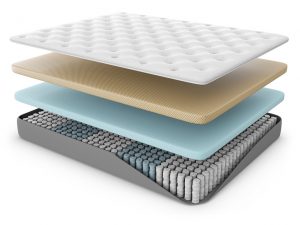 Why settle for one when you can have the best of both worlds combined in a single mattress? It’s the idea behind the hybrid mattress. Experience the benefits of both technologies, an innerspring and memory foam or latex, while eliminating the limitations of each. With superior support and a contouring comfort rolled into one, what else could you ask for?
Why settle for one when you can have the best of both worlds combined in a single mattress? It’s the idea behind the hybrid mattress. Experience the benefits of both technologies, an innerspring and memory foam or latex, while eliminating the limitations of each. With superior support and a contouring comfort rolled into one, what else could you ask for?
Pros
- A hybrid mattress offers superior edge support and distributes weight evenly.
- It offers a more efficient contour than a traditional innerspring mattress.
- With memory foam or latex on the top layer, the hybrid mattress offers better airflow, resulting in good breathability.
- It offers just the right bounciness for comfortable sleeping and responsiveness to help you get off the bed.
- It comes in different firmness levels.
- It offers outstanding motion isolation.
Cons
- Since it has added features, a hybrid mattress can cost more than a traditional innerspring mattress.
- It can be heavy and difficult to move.
- If the top layer is made of memory foam, there can be off-gassing. Letting it air out dissipates the smell.
- Some manufacturers label a mattress as a hybrid, when in fact, it’s not. Take time to scrutinize what you intend to buy.
Mattress Budget: How much are you willing to spend?
 Since you can’t have a mattress for free, be ready to shell out some bucks to buy your perfect mattress. As budget differs per person, set the maximum amount you are willing to spend and work within the budget. Topple the usual misconception in mattress buying and consider the following tips when you set your budget:
Since you can’t have a mattress for free, be ready to shell out some bucks to buy your perfect mattress. As budget differs per person, set the maximum amount you are willing to spend and work within the budget. Topple the usual misconception in mattress buying and consider the following tips when you set your budget:
The price isn’t equal to the quality. Be a smart-buyer. Don’t fall for the trap of some companies. You might end up paying only for the brand name instead of a quality mattress. Buy the mattress that works for you.
You get what you pay for. Yes, you may be on a tight budget, but buying a cheap mattress just for the sake of having a new one won’t do you any good. You might end up with poor quality, less durable, and less safe mattress. We don’t want you to feel regretful about your purchase.
Mattress size matters. As the size of the mattress increases, so as its price to some extent. So, if you’re planning to buy a bigger mattress, say a King or California King-size, increase your budget to explore more choices within your desired price range.
Mattress Firmness: What firmness level do you prefer?
Answering the question to get the mattress with the firmness level you prefer, plays a critical role in your overall sleeping experience. Yes, it’s a matter of personal preference, but there’s more to it, especially if you have to take into consideration your weight as well as your sleeping position/s. For now, let’s discuss the choices you have in terms of how firm a mattress is according to how manufacturers sort them apart.
Firmness Level
Soft (1-2)
A mattress with 1 or 2 firmness rating can be the softest and body-conforming sleeping surface. It offers the least body support, making the body sink in easily on the mattress the moment you sit or lie down on it. People who sleep on their sides can find comfort in this type of bed. The only drawback with a super-soft mattress like those of memory foams is it tends to trap the body heat.
Medium Soft (3-4)
For those who want something in between soft and firm, a mattress with 3-4 firmness ratings can offer the softness of memory foam but without causing you to sink in deeply into the mattress. It usually has firmer memory foam or latex. Even with slightly better support than those super-soft mattresses, it’s still not recommended for sleepers who require spinal alignment.
Medium Firm (5-7)
For a perfect balance of contouring and support, a medium-firm mattress with a firmness rating of 5-7 got you covered. It has a bouncy feeling compared to a medium soft mattress. It works well for most body types and sleeping positions. It has more dense and durable materials compared to the above two mentioned mattresses.
Firm (7-10)
If you prefer the feeling of sleeping on top of the bed without totally sinking in, then a mattress with a firmness level between 7-10 may work well for you. This type of mattress offers superior support. It’s an ideal choice for those who need a high level of spinal support and often wake up with back pain. It promotes excellent airflow, allowing a cool sleep.
Sleeping Position: What position/s do you sleep in?
Don’t you know your preferred sleeping position plays a big role in choosing the best mattress for you? Knowing which type of mattress works well with your sleeping style can lead to a better sleeping experience, with zero body aches and grogginess.
Side Sleeper
People who sleep on their sides can find comfort sleeping on a soft memory foam or any mattress with built-in pressure relief points around the shoulders and hips. Although, when it comes to pressure relief, body weight support, and body contouring, an innerspring mattress can do the job efficiently.
Stomach Sleeper
For stomach sleepers, a dense foam or innerspring mattress can provide superior support. Stay away from a memory foam that can make you feel suffocated.
Random Position Sleeper
For those who always change their sleeping position or have a partner that has a different sleeping position than you, a foam mattress that has soft and firm sides can do the trick. Check out the reversible Layla Mattress that lets you experience each side whenever you want. You can choose a medium-firm mattress if you sleep on your back most of the night or a medium-soft mattress if you always roll over and wind up on your side.
Back Sleeper
If you sleep on your back, then congratulations! According to the sleeping experts, It’s the best sleeping position that promotes well-being. With no extra pressure on your head, neck, and spine as they rest in a neutral position, you’re less likely to wake up with body pain. In short, you’ll be well-rested. In terms of mattress type, you can sleep comfortably on any mattress with a medium-firm and even firm-level that offers support without sacrificing comfort.
Weight Consideration: How much do you weigh?
To each his own, so as for mattresses. You can’t expect the same mattress to satisfy you and work the same as for others. Choosing a mattress that works well with your body type, especially your weight, gives you a ticket to a deep slumber. Consider the following guides on how to choose a mattress depending on your body weight.
Lightweight people (130 lbs or less)
Since lightweight people who weigh around 130 lbs or else have less compression force on the mattress, considering a memory foam or latex can be a viable choice. They tend to just settle on the upper comfort level of the mattress. They can opt for a slimmer mattress.
Average-Sized People (130-200 lbs)
Medium-soft and medium-firm mattresses are ideal for average-sized sleepers. However, for those suffering from backaches or sleep on their stomach, it is best to get a firm mattress for superior support.
Heavy-Weight People (200 lbs or more)
For those who weigh about 200 lbs or more, it is best to get a dense mattress that has a strong support core. A medium-firm or firm mattress works well for them since it will prevent them from sinking deep into it.
